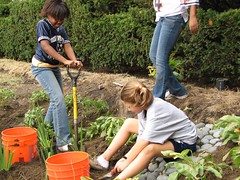Upcoming meetings to learn more about Alcosan's plan being formulated are 11/14/11 10:00 to Noon at the Undercliff Fire Hall on 700 Mount Royal Road in Pittsburgh, PA 15223, 11/14/11 from 5:30 to 7:30 PM at Gateway Hall, Monroeville Fire Dept. # 4, 4370 Northern Pike, Monroeville, PA 15146 and the final public meeting will be an all day event on Tuesday, November 15, 2011 at the Senator John Heinz History Center, 1212 Smallman Street, Pittsburgh, PA 15222. This final region wide meeting will be all day, from 10:00 AM to 4:00 PM.
Below is an excellent piece from the Center for Neighborhood Technology in Chicago. This is an wonderful beginning. There are examples of many of these types of green infrastructure efforts around the Pittsburgh region. The full reference is listed at the bottom of this page. Elisa Beck
What is Green Infrastructure?
Green infrastructure is the interconnected network of open spaces and natural areas, such as greenways, wetlands, parks, forest preserves and native plant vegetation, that naturally manages stormwater, reduces flooding risk and improves water quality. Green infrastructure usually costs less to install and maintain when compared to traditional forms of infrastructure. Green infrastructure projects also foster community cohesiveness by engaging all residents in the planning, planting and maintenance of the sites.
Raingardens

- Rain gardens recharge groundwater sources, meaning that fewer pipes need to be installed to move water around the region.
- They help protect communities from flooding and drainage overflow and provide valuable wildlife habitat.
- Additional benefit: costs less to maintain than traditional forms of landscaping.
A rain garden is a man-made depression in the ground that is used as a landscape tool to improve water quality and reduce flooding. The rain garden forms a “bioretention area” by collecting water runoff and storing it, permitting it be filtered and slowly absorbed by the soil.
Wetlands Restoration

- In addition to capturing and slowing water and improving water quality, wetlands provide valuable wildlife habitat and recreational opportunities (hunting, fishing, bird watching).
Wetlands are areas where water covers the soil, or is present either at or near the surface of the soil all year or for varying periods of time during the year, including during the growing season.
Trees

- Tree windbreaks reduce residential heating and cooling costs by 10-50 percent.
- Trees reduce air pollution and there is increasing evidence that they play a role in reducing crime.
- Unlike sewers and built infrastructure, trees appreciate in value and require less maintenance as they age.
Green Roofs

- Depending on rain intensity and greenroof soil depths, runoff can be absorbed between 15 to 90 percent, thereby considerably reducing runoff and potential pollutants from traditional impervious roofing surfaces.
- Overall building energy costs can be reduced due to the greenroofs’ natural thermal insulation properties— structures are cooler in summer and warmer in winter.
Swales

Swales typically have several advantages over conventional storm water management practice, such as storm sewer systems, including:
- the reduction of peak flows;
- the removal of pollutants,
- the promotion of runoff infiltration, and
- lower capital costs.
Porous Pavement

- reduces impervious areas,
- recharges groundwater,
- improves water quality, and
- eliminates the need for detention basins.
Native Landscaping

- Native landscaping attracts a variety of birds, butterflies and other animals, supporting biodiversity.
- Once established, native plants do not need fertilizers, herbicides, pesticides or watering, thus benefiting the environment and reducing maintenance costs.
Greenways

- Streambanks along trails & greenways provide more surface area for natural absorption to lessen necessary sewer capacity.
- Trees slow down and clean water before it enters a stream or sewer.
- Additional benefits: increased tourism and opportunities for physical activity; increased property values.
Greenways are privately or publicly owned corridors of open space which often follow natural land or water features and which are primarily managed to protect and enhance natural resources.
Featured Publications
Read our Green Solutions Manual
Water: From Trouble to Treasure(2.1mb, .PDF) 01/16/07
Related News
October 26th, 2011 Money Doesn’t Grow on Trees, For Now
A new CNT study shows that Portland is well-positioned to pilot a tree asset management program that would lay the groundwork for turning its tree canopy into a bondable asset, similar to bridges and roads. The study identified six steps through…
October 12th, 2011 Chicago Mayor Proposes Increase in Water Rates to Fund Infrastructure Improvements
CNT welcomes Mayor Rahm Emanuel’s move to modernize Chicago’s water infrastructure through increased, and arguably fairer, rate prices. The decision will reduce the amount of water lost through leaks in crumbling pipes, and improve the system’s ability to deal with…
September 27th, 2011 Wangari Maathai Memory Lives on at Al Raby School in Chicago
We at CNT are saddened to learn of the passing of 2004 Nobel Peace Prize Laureate Wangari Maathai, founder of the Green Belt Movement. Wangari Maathai Memory Lives on at Al Raby School in Chicago. CNT was honored to have Ms. Maathai join us at the dedication of one of our first green infrastructure projects, located at the Al Raby School for Community and Environment and named in her honor.
CNT Update Mailing List:


what your character looks like, they may have trouble connecting with them on a personal level, or caring about their plight. plumbing upland
ReplyDelete